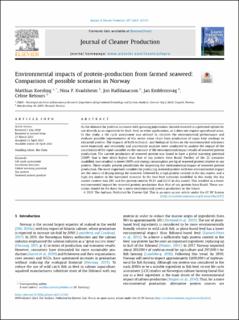| dc.contributor.author | Koesling, Matthias | |
| dc.contributor.author | Kvadsheim, Nina Pereira | |
| dc.contributor.author | Halfdanarson, Jon | |
| dc.contributor.author | Emblemsvåg, Jan | |
| dc.contributor.author | Rebours, Celine | |
| dc.date.accessioned | 2022-03-17T10:05:04Z | |
| dc.date.available | 2022-03-17T10:05:04Z | |
| dc.date.created | 2021-05-11T12:24:06Z | |
| dc.date.issued | 2021-07-20 | |
| dc.identifier.citation | Journal of Cleaner Production. 2021, 307 . | en_US |
| dc.identifier.issn | 0959-6526 | |
| dc.identifier.uri | https://hdl.handle.net/11250/2985762 | |
| dc.description.abstract | As the demand for proteins increases with growing populations, farmed seaweed is a potential option for use directly as an ingredient for food, feed, or other applications, as it does not require agricultural areas. In this study, a life cycle assessment was utilised to calculate the environmental performance and evaluate possible improvements of the entire value chain from production of sugar kelp seedings to extracted protein. The impacts of both technical- and biological factors on the environmental outcomes were examined, and sensitivity and uncertainty analyses were conducted to analyse the impact of the uncertainty of the input variables on the variance of the environmental impact results of seaweed protein production. The current production of seaweed protein was found to have a global warming potential (GWP) that is four times higher than that of soy protein from Brazil. Further, of the 23 scenarios modelled, two resulted in lower GWPs and energy consumption per kg of seaweed protein relative to soy protein. These results present possibilities for improving the environmental impact of seaweed protein production. The most important variables for producing seaweed protein with low environmental impact are the source of drying energy for seaweed, followed by a high protein content in the dry matter, and a high dry matter in the harvested seaweed. In the two best scenarios modelled in this study, the dry matter content was 20% and the protein content 19.2% and 24.3% in dry matter. This resulted in a lower environmental impact for seaweed protein production than that of soy protein from Brazil. These scenarios should be the basis for a more environmental protein production in the future. | en_US |
| dc.language.iso | eng | en_US |
| dc.publisher | Elsevier Ltd. | en_US |
| dc.rights | Navngivelse 4.0 Internasjonal | * |
| dc.rights.uri | http://creativecommons.org/licenses/by/4.0/deed.no | * |
| dc.title | Environmental impacts of protein-production from farmed seaweed: Comparison of possible scenarios in Norway | en_US |
| dc.type | Peer reviewed | en_US |
| dc.type | Journal article | en_US |
| dc.description.version | publishedVersion | en_US |
| dc.rights.holder | © 2021 The Authors | en_US |
| dc.source.pagenumber | 15 | en_US |
| dc.source.volume | 307 | en_US |
| dc.source.journal | Journal of Cleaner Production | en_US |
| dc.identifier.doi | 10.1016/j.jclepro.2021.127301 | |
| dc.identifier.cristin | 1909424 | |
| dc.relation.project | Norges forskningsråd: 244244 | en_US |
| dc.source.articlenumber | 127301 | en_US |
| cristin.ispublished | true | |
| cristin.fulltext | original | |
| cristin.qualitycode | 2 | |

